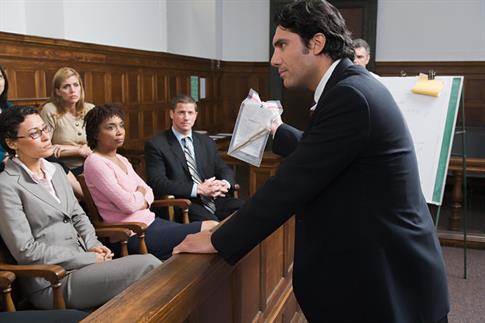HOW TO WRITE A PROSECUTION CLOSING ARGUMENT FOR MOCK TRIAL
At the conclusion of the trial, when all witnesses have testified, it is time for closing arguments. Because the prosecutor has the burden of proof, he or she has the opportunity to address the jury twice. It works like this: the prosecutor makes a closing argument, then there is the defense closing argument, and then the prosecutor gets to address the jury a second time. As we will discuss, this second closing argument can be a little bit tricky to plan for.
Unlike an opening statement, which you can script-out in well in advance
of the trial, a closing argument requires you to think on your feet. Until
the trial is over you don’t know what evidence will be admitted,
or what testimony will be allowed (due to objections). You will be scored
in a mock trial based on how well your closing argument incorporates what
actually occurred at the trial. Every year when judging mock trial competitions,
I have seen students deliver a pre-written closing argument that includes
things at trial that the judge actually did not allow in to the trial
due to objections. This should be avoided.
Covering the Elements
Fundamentally, you should remember when writing your closing argument that you, as a prosecutor, have the burden of proof. So you need to convince the jury that you have met your burden of proof. This means you need to establish that all elements of the crime have been shown. Every criminal offense has certain elements. For example for first degree murder, the elements are that the defendant 1) caused the death of another human being, and 2) acted with the intent to cause the death, and 3) did so with premeditation. The elements of the crime of residential burglary are that the defendant 1) entered or remained unlawfully within the property of another, 2) that property was a dwelling, and 3) the defendant entered with the intent to commit a crime against a person or property therein. So when writing a prosecution closing argument, you need to make certain that you know the elements of the crime charged, and you should speak to each element. Addressing this might go something like this:
I would like to next address each element of the offense of murder, and explain how each element has been proven. First it is clear that the defendant caused the death of his wife. The defendant was the only one behind the wheel when he struck her with his car. No one else was driving. His wife was in good health that day when she was walking down the street. She would not have died if it weren’t for being struck by the defendant’s vehicle. Next, let’s turn to the subject of intent. It is clear that the defendant struck his wife with the intent to kill her. Why else would he have taken out an insurance policy on her? Also, look at the defendant’s own words. He said to his mistress in a text message the day prior “This will all be over soon.” Certainly it was his intent to kill her. You should not believe the defendant’s claim that this was an accident. Lastly, as to the element of premeditation, the defendant’s text messages also show that he had planned this crime for at least several days in advance. Accordingly, the state has met its burden of proving each element beyond a reasonable doubt, and you should convict the defendant of first degree murder.
You can structure any closing argument in any criminal case the same way. You need to break down what the elements of the offense are, and how each element is met.
During your closing argument, you should also anticipate the points that the defense may bring up during their closing. Which element of the crime is the defendant actually contesting? In this example above it is unlikely that the defendant is contending that he was not the driver. So after the defendant has testified you will need to adjust your closing argument accordingly. In mock trial competitions (as opposed to real life) the packet you receive from your teacher usually gives you an idea what the defendant’s theory of the case was.
So as I mentioned, you will want to spell out how each element of the offense has been proven.
Conveying the Emotion of a Case
It is important for a prosecutor to remind a jury that they are dealing with a real person or real human being who has been a victim of a crime. It is often a fine line between conveying the emotion to a case and using inflammatory language that will draw an objection. Here is an example:
Martha Jones would still be alive today if it weren’t for the actions
of her husband. She started that day just like many other citizens of Columbus. She simply walked to the corner store for some groceries. She didn’t
ask to be run over, and she wasn’t doing anything else that day
other than going about her life like really any of us would. She didn’t
know that her husband was being unfaithful, she didn’t know that
her husband was planning her death, and she didn’t know that her
husband was stalking her and waiting for her to cross the street. Martha
Jones was not alive here today to tell her story. But she speaks today
through the other witnesses and physical evidence. And all that evidence
points to her husband, and all that evidence points that this was an intentional
act. And that is disturbing, isn’t it. It is disturbing that anyone
would do such a heinous act as running their spouse down in a crosswalk.
But that is what happened, and we can’t shy away from it just because
it is disturbing. The defendant must be held accountable. Martha Jones
didn’t stand a chance that day. She was unarmed and unaware that
she was about to be ambushed by the very man that took a vow to honor
and love her. The correct verdict is guilty.
She simply walked to the corner store for some groceries. She didn’t
ask to be run over, and she wasn’t doing anything else that day
other than going about her life like really any of us would. She didn’t
know that her husband was being unfaithful, she didn’t know that
her husband was planning her death, and she didn’t know that her
husband was stalking her and waiting for her to cross the street. Martha
Jones was not alive here today to tell her story. But she speaks today
through the other witnesses and physical evidence. And all that evidence
points to her husband, and all that evidence points that this was an intentional
act. And that is disturbing, isn’t it. It is disturbing that anyone
would do such a heinous act as running their spouse down in a crosswalk.
But that is what happened, and we can’t shy away from it just because
it is disturbing. The defendant must be held accountable. Martha Jones
didn’t stand a chance that day. She was unarmed and unaware that
she was about to be ambushed by the very man that took a vow to honor
and love her. The correct verdict is guilty.
The Rebuttal
As I mentioned above, the prosecutor speaks twice in a closing argument, so he or she has an opportunity to give a rebuttal to the defense lawyer’s closing. This requires you to think on your feet a little bit. It means you will have to listen closely to what the defense lawyer is saying. The basic framework is to get up and say: “The defense lawyer argued ____, and I would respond by saying ______” Here is an example:
Thank you again for your attention. As I explained earlier, I have a brief opportunity to respond to the defense lawyer’s closing. I just want to make two quick points. Defense counsel made the argument that it is not uncommon for a person to have life insurance policy on their spouse. I would agreed. However the time that he took out the life insurance policy was highly suspicious. It was just one week before his wife’s death. And they had been married for over 10 years, so why did he wait so long? The defense lawyer pointed out that no one had seen the accident. That is true, but the defendant’s vehicle was leaving the scene two blocks away, and the victim’s DNA was found on the vehicle. So I ask you, members of the jury, is that really reasonable doubt? Or is this just more excuses from a man who doesn’t want to be held accountable? We would ask you for a verdict of guilty.
